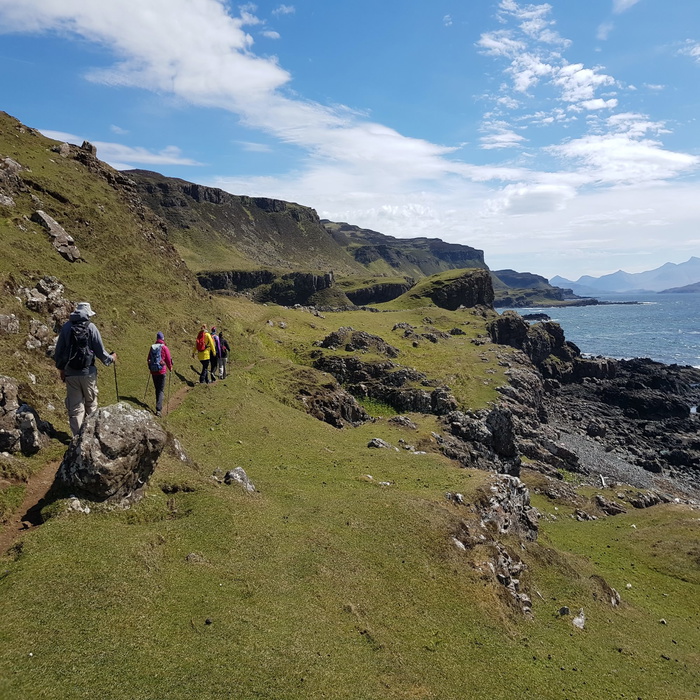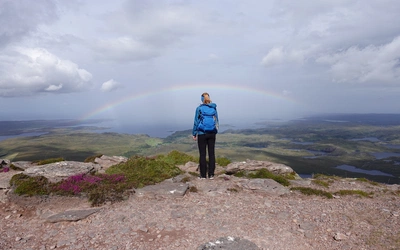9 reasons why the Isle of Mull is fantastic for low-level walking
The Isle of Mull is part of the Inner Hebrides, the group of islands that run up the spectacular west coast of Scotland from Arran to Skye. It sits approximately half-way up, wedged into the sea between Morvern and the Argyll coast. Mull lacks the mountaineering spectacle of Skye and the remote romance of the smaller islands, but easily has the best low-level walking in Scotland. Here are 9 reasons why Mull is fantastic for low-level walking.
15 Short Walks on the Isle of Mull
£9.95
Discover 15 of the best short walks on the Isle of Mull, including Ulva and Iona. Each walk comes with easy-to-read Ordnance Survey maps, clear route description and lots of images, plus information on beauty spots and refreshment stops. No challenging terrain or complicated navigation means walks can be enjoyed by everyone.
More information
1. There are real paths
As a Mountain Leader and a guidebook author, I know the value of a good path! In the Scottish Highlands low-level paths are often based on the droving roads or military tracks that run through the valleys so are therefore linear. This, plus the size of the mountain massifs themselves, makes it hard to create good, circular low-level walks. When it is possible to circumnavigate a massif, you could be out for days!
Not so on Mull; there is an excellent range of paths that do not just appear in the guidebooks and on the maps, but are present on the ground and straightforward to follow. The geography of the Hebridean island – a central band of mountains with much lower peninsulas striking off in all directions – means that circular walks are a natural way of moving through the land, taking the walker around a headland or through a set of valleys. Probably due to this natural ease and their popularity, earth paths have materialised on many of these walks.

2. Lots of wildlife
There’s no need to travel abroad to see charismatic wildlife, and in the UK the islands of Scotland must hold the crown for large animal diversity. Of all these islands, I’ve seen the most wildlife on Mull. The sea eagles are rightly famous here, and there’s nothing more exciting than getting up at dawn to wait for the slightest glimpse of an otter. Out in the sea in the summer you can see passing whales and dolphins, and even basking sharks.
Besides the quest to see these rarer and more elusive sights, what attracts me to Mull is the huge number of other species that you will see. Walk within view of small, rocky islands and there will undoubtedly be seals; relax in the sun on the beach overlooking the Sound of Mull and watch the seabirds hunt, listening to the screeching call of the oystercatchers with their vibrant red bills; and wander over the low, grassy hills in spring to find all sorts of wildflowers, from orchids to wild thyme to yellow iris.

3. Every type of coast
As Brits, we’re all islanders and chances are, love sauntering by the sea whether the view is of the sandy bays of Cornwall or the sea stacks of the Northern Isles. So, it should come as no surprise that one of the main attractions on Mull is its accessible coastal walking. And importantly for all walking destinations, it’s the huge variety that means this is a coastline to keep coming back to.
The nature of the geology – great stepped lava fields, some of which have been cut into by the ancient sea and then risen up – has created ‘raised beaches’, which essentially means that as a walker you have a ready-made level platform, with the sea on one side and cliffs on the other. Where the ocean cuts into the land at the sea lochs the coast is low and rocky, with grassy platforms where you can picnic and watch the waves. Finally, we have the beaches. Although the blinding white sands and stunning sunsets of Calgary Bay are the most well-known, it’s not hard to reach secluded sandy hideaways anywhere on the island.

4. History from every age
Although there is evidence of Neolithic life on Mull, including a few standing stones and a stone circle, many of the sites and stories come from the first millennium and the medieval period. Mull’s position made it an attractive place for the Vikings, and later it became part of the realm of the Lord of the Isles, which for much of the medieval period remained independent from the Scottish crown. The castles that can be seen up the east coast on several walks, which controlled shipping along the Sound of Mull, were testament to this power.
Long before this, St Columba landed on Iona, just off the coast of Mull, and from the abbey started to spread Christianity throughout Scotland. In more recent times, the Isle of Mull suffered during the Highland Clearances, when people were forcibly evicted and replaced by sheep. Although the figures themselves describe this tragic part of history enough (the Isle of Ulva went from a peak of 600 people to the modern figure of around 12), you will find on Mull former villages and houses, whose walls are almost complete. It is a haunting presence in the landscape.

5. Inspirational offshore islands
The beauty of walking on the coast on Mull lies not just in the immediate view, but in the islands that you can see offshore. Across the Sound of Mull, you can see the mainland, but with a little height gain and a clear day, looming on the horizon are the hills of Rum and Skye, including the Black Cuillin. On the west coast, the Treshnish Isles present the perfect set of wave-battered rocky hideaways, but there are other, closer islands that you can easily get to for a walk or to explore.
At the end of the Ross of Mull, the southern peninsula of the island, and separated by barely half a mile, lies the holy island of Iona, home to St Columba’s abbey, and with some excellent beaches and remote walks to make it worthy of a full day out. From Iona it’s also possible to reach Staffa, with its famous basaltic columns and the colossal mouth of Fingal’s Cave. Many tours land on the island to allow you an hour or so to wander round, and in the spring and early summer to see the puffin colony. Close to Fionnphort lies the less-visited Isle of Erraid, which you can walk to only at low tide and which stars in the novel Kidnapped by Robert Lewis Stevenson.
Less well known is the island of Ulva, meaning 'Wolf Island', half way up the west coast of Mull. It is separated by only 150 metres of sea and you signal for the small passenger ferry by uncovering a coloured flag. Ulva has some excellent walks, all of which are signposted. You can reach the highest point on the island, the bay at the back near Ormaig where seals often bask, or simply make a pleasant loop around the nearest headland, visiting sites as diverse as a standing stone from 4000-plus years ago, to the croft where the explorer David Livingstone’s family used to live in the 19th century.

6. Easy to get to
Considering the remoteness that can be readily be found on the Isle of Mull, it’s extremely easy to get to, especially compared with other parts of western Scotland, and many of the wild places of England and Wales. The ferry from the mainland goes from Oban, which is just over 3 hours on the train from central Glasgow. The ferry journey itself is under an hour, meaning you can be on an island and by the sea within 5 hours from the centre of Scotland’s largest city!
It’s worth pointing out that there’s another ferry to Mull from Lochaline, although unless you’re coming from the north-west coast of Scotland this is unlikely to be an easier route, unless you want to visit the often-overlooked lands of Argour and Morvern, west of Fort William, on your way.
Of course, you can put your car or bike on the ferry and make use of the freedom to travel around the island, but there is also a bus route for most of the island.

7. Art and food
It is not just the unique walks and wildlife that draw so many people to Mull; there are plenty of cosier attractions throughout the island. In every town and village there are excellent pubs, cafés and restaurants that will keep you busy searching for the best possible tea break or dinner with a sea view. Whether you want classic pub food or the freshest local seafood, you’ll find it on Mull; and there’s always somewhere nearby to escape for cake and a cuppa when the weather turns foul.
Something I find astonishing about travelling around Scotland’s islands is how well local artists manage to capture the brilliant light of the north. Whether it’s dramatic paintings of stormy skies, the precision rendering of that incredible sea-blue, or something more abstract, Mull makes its contribution to the perfect expression of this landscape. A great place to start is the art gallery at Calgary or the shore-front in Tobermory.

8. There are easy hills
Hillwalking doesn’t have to mean trying to climb giants; there are plenty of hills that can easily be called ‘low-level’ on Mull and they make an excellent addition to a walk. One major attraction of the low-level hills is that the summits give you that 360-degree view of the landscape that you often miss in the valleys. A bonus is that on the hills you can often find signs of our ancestors, be it Iron Age forts or standing stones, which were built up there to command a view. Last, but not least, they’re the best place to look out for eagles!
It’s Mull’s geology that helps to create these places, with the low landscape created by the ancient lava flows rising to high points that have been enhanced by glaciation. Some wonderful examples of these low hills are Meall an Inbhire (264m) near Tobermory, Bràigh a Choire Mhòir (159m) near Salen, and Dun I (101m) on Iona. Because of Scotland’s fantastic open access laws, the hills of the Isle of Mull are open for exploration even if they’re not featured on a route within a walking guide.

9. Did I mention eagles?
Of all the wildlife on Mull, possibly the most charismatic are the eagles. Mull has populations of both the golden eagle, which occurs through much of the rest of Scotland, and the iconic white-tailed eagle. These larger birds were driven to extinction 100 years ago by persecution, but reintroduced in the 1970s, and the first successful breeding between white-tailed eagles occurred on Mull in the mid-1980s. Along with other introductions that have been a success in the UK in recent decades, the eagles show that with the help of man, recent local extinctions can be reversed, and a more enlightened view of the natural world acquired as a result.
Several organisations operate ‘eagle watches’ on Mull, which you can join when you’re there, to increase your likelihood of seeing the eagles, or even to view the nests. They have famously been described as like ‘a barn door’, so large is their wingspan in flight.
Walking on Mull, Coll and Tiree
50 walks including Iona and Ulva
£16.95
Guidebook describing 50 walking routes on Scotland's beautiful Isle of Mull, as well as neighbouring Coll, Tiree, Iona and Erraid. Walks range from 1 to 12 miles and from short circuits to demanding mountain traverses, but without technical difficulties. The Isle of Mull is wild, rugged and great for wildlife spotting.
More information












